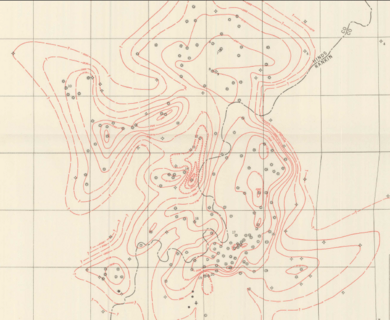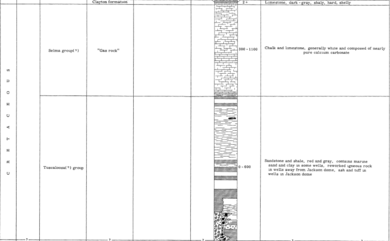Jackson Volcano facts for kids
Quick facts for kids Jackson Volcano |
|
|---|---|
| Highest point | |
| Elevation | 2,900 ft (880 m) below Jackson |
| Geography | |
| Location | Jackson, Mississippi |
| Geology | |
| Age of rock | 66,000,000 years |
| Mountain type | (unknown, extinct) |
| Last eruption | Cretaceous |
The Jackson Volcano is an extinct volcano located deep beneath the city of Jackson, Mississippi. It sits about 2,900 feet (880 meters) underground, right below the Mississippi Coliseum. Even though you can't see it, this volcano has shaped the land above it.
The ground around the volcano is pushed up, forming an area called the Jackson Dome. This dome is made of very dense rock. Scientists can easily spot it using special tools that measure gravity. Back in 1860, a scientist named E.W. Hilgard first guessed there was a dome under Jackson. He noticed how the layers of rock on the surface were shaped.
The Jackson Dome holds a special gas called carbon dioxide. This gas is very pure and is used to help get oil out of the ground in nearby oil fields. Scientists have studied gases from the dome. They think the volcano formed about 70 million years ago from deep inside the Earth. Over millions of years, the land here has been pushed up many times. During these times, hot rock (magma) pushed through cracks, and lava flowed out. Then, the land would wear away, and new layers of dirt and rock would settle. At one point, a coral reef even grew there when the area was underwater! Much of the oil that was once at the top of the dome turned into gas during a later uplift. Still, by 1934, there were over a hundred oil wells here.
Scientists believe the Jackson Volcano has been extinct for at least 66 million years. This means it hasn't erupted in a very, very long time. One idea is that the Jackson Volcano formed when the North American Plate (the huge piece of Earth's crust we live on) moved over a "hotspot" in the Earth's mantle, like the Bermuda hotspot, about 66 million years ago. Another idea is that this volcano was part of a huge wave of eruptions around the world. These eruptions might have been caused by "superplumes," which are giant columns of hot rock rising from deep inside the Earth. This is similar to how other massive volcanic areas, like the Deccan Traps in India and the Siberian Traps in Russia, were formed.
The Jackson Volcano is one of only four volcanoes in the United States that are located inside cities. The others are Diamond Head in Honolulu, Hawaii; Pilot Butte in Bend, Oregon; and Mount Tabor in Portland, Oregon. People first discovered the Jackson Volcano in 1819.
How the Jackson Volcano Formed
Millions of years ago, during the Upper Cretaceous period, a large inland sea called the Western Interior Seaway covered much of what is now Mississippi. This sea left behind layers of rock and sediment, including the Tuscaloosa Formation.
The Jackson Volcano was part of a series of volcanic events that happened in an arc shape across the northern Gulf of Mexico. This volcanic activity started about 110 million years ago in the west and moved eastward. The Jackson Dome, which formed about 70 million years ago, was one of the last events in this series.
When the Jackson Volcano formed, the hot rock pushed up and changed the existing rock layers, creating the dome shape we see today. Because of this, the Tuscaloosa Formation near the dome contains volcanic ash and other volcanic materials. Volcanic material is also found in another layer of rock called the Eutaw Formation.
Later, the land sank, and sea levels rose again. This led to the formation of chalk and limestone layers, known as the Selma Group. Natural gas collected in a special limestone layer within the Selma Group. People first noticed this rock structure in 1917, and a successful gas well was drilled in 1930. However, most of the gas was used up by 1939. Volcanic ash from the Jackson Volcano, found in the Eutaw Formation, also helped create oil in the Tinsley Oil Field.



